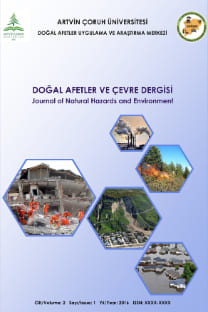Samsun İli için Sıcak Hava ve Soğuk Hava Dalgalarının Zamansal Analizleri
Sıcak Hava Dalgası, Soğuk Hava Dalgası, Samsun
Temporal Analysis of Heat Waves and Cold Waves for Samsun Province
Heat Wave, Cold Spell, Samsun,
___
- Aksu H., (2021), Nonstationary analysis of the extreme temperatures in Turkey, Dynamics of Atmospheres and Oceans, 95, 101238, doi: 10.1016/j.dynatmoce.2021.101238.
- Aykır D., (2017), Türkiye’de ekstrem sıcaklık indislerinin eğilimlerinde şehirleşmenin etkisi, Türk Coğrafya Dergisi, (69), 47-57.
- Canyılmaz G.C., Efe B., (2020), Edirne, Tekirdağ, Kırklareli, İstanbul illerinde atmosferik engelleme ve sıcak-soğuk hava dalgaları ilişkisi, Journal of Anatolian Environmental and Animal Sciences, 5(3), 611-617.
- Curriero F.C., Heiner K.S., Samet J.M., Zeger S.L., Strug L., Patz J.A., (2002), Temperature and mortality in 11 cities of the eastern United States, American Journal of Epidemiology, 155(1), 80-87.
- Çelik S., Bacanlı H., Görgeç H., (2008), Küresel iklim değişikliği ve insan sağlığı üzerine etkileri, Telekomünikasyon Şube Müdürlüğü, https://mgm.gov.tr/FILES/genel/makale/11_kureseliklimdegisikligietkileri.pdf, [Erişim 20 Şubat 2021].
- Demirtaş M., (2018), The high-impact 2007 hot summer over Turkey: atmospheric-blocking and heat-wave episodes, Meteorological Applications, 25(3), 406-413.
- Demirtaş M., (2017), The large-scale environment of the European 2012 high-impact cold wave: prolonged upstream and downstream atmospheric blocking, Weather, 72(10), 297-301.
- Frich P., Alexander L.V., Della-Marta P., Gleason B., Haylock M., Klein Tank A.M.G., Peterson T., (2002), Observed coherent changes in climatic extremes during the second half of the twentieth century, Climate Research, 19(3), 193-212.
- Google Labs, (2021), Google Earth, https://www.google.com/intl/tr/earth/, [Erişim 20 Şubat 2021].
- Hansen A., Bi P., Nitschke M., Ryan P., Pisaniello D., Tucker G., (2008), The effect of heat waves on mental health in a temperate Australian city, Environ Health Perspect, 116(10), 1369-1375.
- Özgür E., (2020), A Comparative Investigation of Temperature Persistence: A Case Study of Western Turkey, MESAEP 20th International Symposium on Environmental Pollution and its Impact on Life in the Mediterranean Region, 26 - 27 October, Athens, Greece, ss.78.
- Robine J.M., Cheung S.L.K., Le Roy S., Van Oyen H., Griffiths C., Michel J.P., Herrmann F.R., (2008), Death toll exceeded 70,000 in Europe during the summer of 2003, Comptes Rendus Biologies, 331(2), 171-178.
- Robinson P.J., (2001), On the definition of a heat wave, Journal of Applied Meteorology and Climatology, 40(4), 762-775.
- Türkeş M., (2001), Hava, iklim, şiddetli hava olayları ve küresel ısınma, Devlet Meteoroloji İşleri Genel Müdürlüğü 2000 Yılı Seminerleri, Teknik Sunumlar, Seminerler Dizisi: 1, Ankara, ss.187-205.
- Türkeş M., (2008), Küresel iklim değişikliği nedir? Temel kavramlar, nedenleri, gözlenen ve öngörülen değişiklikler, İklim Değişikliği ve Çevre, 1, 26-37.
- URL-1, (2018), R Core Team, R: a language and environment for statistical computing, R Foundation for Statistical Computing, https://www.R-project.org/, [Erişim 16 Şubat 2021].
- Wickham H., (2017), tidyverse: Easily Install and Load the 'Tidyverse', R package version 1.2.1, https://CRAN.R-project.org/ package=tidyverse, [Erişim 16 Şubat 2021].
- Yang J., Yin P., Sun J.M., Wang B.G., Zhou M.G., Li M.M. et al., (2019), Heatwave and mortality in 31 major Chinese cities: definition, vulnerability and implications, Science Total Environment, 649(2019), 695-702.
- ISSN: 2528-9640
- Yayın Aralığı: Yılda 2 Sayı
- Başlangıç: 2015
- Yayıncı: Artvin Çoruh Üniversitesi Doğal Afetler Uygulama ve Araştırma Merkezi
Düzce İli İçin Senaryo Bazlı Risk Değerlendirmesi
Zeynep MIHÇI, Hüseyin BAYRAKTAR
Küresel Isınmanın Etkisi Altında Sürdürülebilir Mimari Tasarım
Samsun İli için Sıcak Hava ve Soğuk Hava Dalgalarının Zamansal Analizleri
Rapor Edilmeyen Sızıntıların Yönetiminde Aktif Kaçak Kontrolünün Planlanması ve Sahada Uygulanması
Mahmut FIRAT, Mustafa YILDIRIM
Sel Afetlerinde Acil Sağlık Hizmetlerinin Organizasyonu ve Yaşanan Sorunlar: Hopa Örneği
Büyük Melen Çayı’nda (Düzce) Günlük Yağışlarla Akım İlişkisinin Analizi
Şehnaz Şule KAPLAN BEKAROĞLU, Sebnem GENISOGLU, Cihan ÖZGÜR
Türkiye Muğla İlindeki Çam Balı Arılıkları için Doğal Afet Riskinin Değerlendirilmesi
Van Gölü Su Yüzeyi Sıcaklıklarının Eğilim Analizi
Kebir Emre SARACOGLU, Fevziye Ayca SARACOGLU
Sanayi Kaynaklı Noktasal Emisyonların Hava Kalitesine Katkısı: Kayseri İli Örneği
